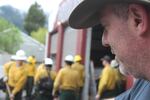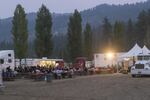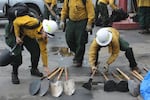With little money and next to no experience, Dillon Sanders staked his business on wildfire. Business has been good.
Each spring, in an old Chevy dealership he converted to an engine garage, training facility and self-described man cave, he trains a fresh batch of wildland firefighter recruits. He makes sure his engines are tuned. He takes stock of protective clothing, tape, water bottles and shovels.
Then he waits impatiently for federal and state fire managers to call.
“I’m a caged lion. I’m pacing, I’m pacing,” he said. His crews need 60 days of work if he’s going to break even for the year.
The 52-year-old Gulf War veteran is the owner of the private contracting outfit Inbound LLC based in Oakridge, Oregon. With 13 engines and 80 crew members, Sanders is fully invested in fire suppression. He wants that to change.
“I’m not in it just for the suppression,” he said. “I’m in it to provide the jobs and provide a healthy forest. My entry into it is suppression. But that’s not the big picture.”
Like many in the wildfire business, Sanders says he’d rather make his money in the steadier, if less lucrative, work of forest restoration, like prescribed burns.
But over the past few decades, the federal government built an industry designed to fight fire, not light it. Concentrated in the Pacific Northwest, these operations have infused government cash into towns and businesses damaged by the loss of timber jobs, and it has provided much-needed reinforcements during intense wildfire seasons when rural communities and forest homes are threatened.
Critics say it also created a special interest that lobbies Congress and federal agencies for policies and funding that support fire suppression, and that the government has escalated costs through inflated pricing and wasteful spending. As Congress and the Forest Service poured more money into firefighting while failing to rein in costs, they undercut their own plans to return forests to healthier, safer conditions.
Forest Service spokeswoman Jennifer Jones said the agency has numerous mechanisms in place to control fire costs. Despite that, its suppression bill jumped to a record $2.4 billion last year.
“It has proven to be very difficult with the increase in large, dangerous fires that threaten lives, property, community infrastructure, and valuable natural and cultural resources that we have been experiencing,” Jones said.
In 1995, wildfire was about 16 percent of the Forest Service budget. A decade later, it took up more than half of it. That is not solely the product of natural disaster, drought or forest fuels. It was part of the plan.

Dillon Sanders looks on as a collection of wildland firefighters train for an upcoming season. Sanders is the owner of Inbound LLC in Oakridge, Oregon, which runs 20-person hand crews and 13 engines for fire suppression.
Tony Schick, OPB/EarthFix
Money To Burn
In the late 1990s, the Forest Service needed a new paradigm. It had lost the stable revenue of logging on national forests, in no small part thanks to environmental lawsuits from advocates like Andy Stahl, a one-time timber lobbyist who now directs Forest Service Employees for Environmental Ethics.
Facing an uncertain future for the Forest Service and the prospect of many out-of-work loggers, the Clinton administration sold Congress on a vision of a new economy around forest restoration, with fire as a major component.
“You have this agency whose raison d'être was logging the national forests. That rug was pulled out from under it. The Forest Service needed to find a new reason for being,” Stahl said.
Then in 2000, after a few intense wildfire seasons, Congress approved close to $1 billion in new funds for the Forest Service and Interior Department to carry out a national fire plan.
Stahl recalled a conversation he had with former Forest Service chief Mike Dombeck during his last days in office back in 2001, who he said was most proud of finding the agency a new revenue stream in wildfire.
Federal Wildfire Suppression Costs
“Well, I certainly wouldn’t put it that way,” Dombeck said when asked about Stahl’s recollection during a September phone interview. “We were transitioning from a logging budget to watershed restoration and watershed health, which fire is part of.”
Dombeck said he envisioned an economy based on jobs to improve forest health — instead of clear cutting national forests, people would work on thinning forests and lighting prescribed burns.
“It was really all about the contractors and the loggers and the communities getting involved and looking at not just how many board feet can we get off the land but what do we want the land to look like and how do we get there,” he said.
In the years that followed, the amount of federal and private resources used on fire suppression skyrocketed, though the rate of prescribed burning stagnated.
The Forest Service soon began borrowing money from its other programs to cover cost overruns from wildfire, a practice Congress hoped to end in 2018 by establishing a separate wildfire disaster fund. Stahl wrote about the Forest Service's expanding wildfire spending in a book published this past summer by the Society of American Foresters.
“The Forest Service’s firefighting costs will continue to go up so long as Congress is willing to pay the tab,” he wrote. “The Forest Service will continue to spend more fighting fires because the war on fire pays its bills.”
Forest Service Staffing Shift
Militia Of Loggers
Once upon a time, wildland firefighting was a militia of loggers and federal employees with separate day jobs.
As Forest Service resources fell, it devoted more of its own employees and equipment to fire full time. Many Northwest loggers and forestry companies found themselves increasingly in the business of fire whether they liked it or not.
The Pacific Northwest now supplies about 75 percent of all contract firefighting resources, according to the National Wildfire Suppression Association. For heavy equipment, it’s closer to 90 percent.

A fire camp in Leavenworth, Washington, during the 2018 fire season.
U.S. Forest Service
Wildland firefighting became organized, regulated and commercialized: Large fire camps include mobile food service, mobile showers and computerized trailers for on-scene mapping. This year, in the Pacific Northwest region, there were 27,501 of these “equipment resources” assigned to fires in the month of August, according to the Forest Service.
“It is more efficient and effective for agencies to contract for those assets than to acquire, manage, and maintain those assets, and to develop and maintain the expertise and experience to operate them in-house,” said Jones of the Forest Service.
The Forest Service hasn't published a thorough accounting of how privatization affects firefighting costs. One agency study in 2005 suggested federal firefighting crews are cheaper so long as they have enough work, while a separate analysis by the National Wildfire Suppression Association, an industry group, found contract crews are a better value. Neither has done a similar analysis for other types of equipment vendors.
Stephen Pyne, professor at Arizona State University and the country’s preeminent wildfire historian, says the loss of federal resources and privatization was touted as a cost saver but over time drove many costs higher.
In researching "Between Two Fires," a modern history of the Forest Service's fire management, Pyne found that by the late 1990s equipment such as fire shelters, shirts and shovels sold commercially for between $30 and $50 more than their cost when supplied through the federal General Services Administration.
“Heavy machinery such as dozers, lowboys, and water tenders, formerly part of the public fire cache, were now contracted at high rates and with stiff premiums for standby availability whether used or not,” Pyne says.
To win government jobs, private companies increased their capacities and improved their equipment. That raised their operating costs. To entice companies to leave a construction or logging job at the last minute and risk upsetting clients, agencies needed to offer higher rates and some guarantee of income.
Wildfire is a sliver of business — but a lucrative one — for Alexander Hodge, a construction contractor in Bend. He said his profit margins typically run 20–30 percent, but when he rents out his equipment on a wildfire, it’s closer to 70 percent.
Waylon Beymer, owner of Chilkat Logging in Warm Springs, Oregon, estimated that in a busy fire season he’s made close to $400,000 in a single month renting out his logging machinery.
The rates paid for such equipment are high for a reason.
“People think that firefighters are shoving all that in their pocket when you’re not,” Beymer said.
He’s running his equipment harder. He’s likely hauling it farther. He’s paying his employees higher wages. All told, he said he’s likely to keep less than 10 percent of what he makes on a fire. And he might burn through an additional $30,000 quickly if he’s lost other job opportunities in the process. So while the money can be good, Beymer said he prefers not to work fires anymore because of the added headaches.
Example fire equipment and resource costs
Most contracts for this kind of work are issued before fire season at agreed-upon rates. But when resources are needed on the fly the emergency can dictate higher prices. Contracting officers describe renting chairs and all-terrain vehicles for more money than it would cost to buy them and renting weeks worth of camp space for as much money as the campground would make in an entire summer.
“You can find examples of the most egregious overcharging. You can also find situations where contractors are forced into things that would put them out of business if this is all they did,” said Stephen Clarke, who worked as a fire contractor for several years based in Eugene.
Clarke served on the board of both the National Wildfire Suppression Association and Firefighters United for Safety, Ethics and Ecology — the latter an environmental group critical of wildfire suppression practices. He said most contractors make every effort to provide the best value.
“In my experience, the truth is sort of in the middle,” Clarke said. “But the in the middle means there are some folks who just take absolute huge advantage of it.”
Concerns over these costs have loomed over wildfire management for many years. They crescendoed a decade ago when the National Academy of Public Administration published a massive paper detailing problems with the Forest Service's contracting on fires. That was followed by a 2005 audit from the U.S. Department of Agriculture's Inspector General and a Pulitzer-winning series in 2008 by the Los Angeles Times exploring the untamed costs of wildland firefighting.
As a result, Congress mandated the Forest Service reduce contracting expenses by 10 percent. In response to emailed questions, the Forest Service did not provide evidence of how it tracked progress toward that 10 percent, whether it met the goal or whether it’s done any audits or other systematic reviews of such costs since.
The Forest Service did revamp its contracting system as a result and incorporated many of the recommendations of previous audits. The agency says prices are reviewed on an annual basis and involve price comparisons from multiple vendors.
While the new system did streamline the process and create more competitive pricing, contract specialists in the Forest Service and Interior Department say it did little to affect baseline rates, the structure of contracts or the agency’s fire spending habits.

An air tanker makes a retardant drop on the South Umpqua Complex fires.
U.S. Forest Service
Part Of The Show
Albert Rollins, a 42-year-old timber faller who worked his first fire at age 18, said for a typical falling gig he’d expect around $400 per day. On a forest fire, he can make closer to $1,200 per day.

Albert Rollins
Tony Schick, OPB / EarthFix
“Whether you start your saw or you don't start your saw,” Rollins said. “It's just insane how much money you can make. I've been on fires and sat there for five days — that's almost $6,000 I made — and I never even put my boots on.”
He said he walked off a fire job once, fed up with the waste he saw.
“It's our tax dollars. It's insane. It's absolutely insane,” he said.
Forest supervisors and incident commanders remain in constant communication about strategies and tactics, which Jones said are the primary driver of costs. She added that all spending on wildfires is done in accordance with established incident business practices.
“There are numerous financial management policies, procedures and controls in place to ensure that expenditures are appropriate,” said Jones, the Forest Service spokeswoman.
Fire managers have every incentive, though, to call more resources and keep them as long as they can — internal performance measures, public pressure and fear of unexpected fire growth.
Fire managers tend to favor more expensive tactics regardless of expected outcome, according to Forest Service surveys. Recent research on firefighting tactics show fire managers commit substantial resources to incidents after fire growth has ceased and call in more resources than necessary for building fire control lines.
Aircraft dropping fire retardant are one of the costliest aspects of firefighting at more than $7,000 an hour. In some situations firefighters consider them an invaluable tool, but studies show they are often used in situations where they're known to be ineffective.
“There’s a lot for show going on, in all of it. Sometimes we’re part of the show. They want to show people they’re responding. They’ll call too many resources,” said Sanders, the contractor from Oakridge. He understands why — bad things can happen if you don't plan for every contingency. "Most of the money is spent on the air show. One of those drops costs what a whole day of us costs."
Sanders noticed as his crews improved, he started getting more of what he considered “rewards” from the Forest Service: After working a few days on an active fire, he’ll be held for a while with no suppression work to do, still in a paid status whether he’s needed or not and put to work brushing roads or improving fire lines.
“It’s make-work,” he said. "But they could just have us sitting around."
During a fire, his fully equipped 20-person crews cost the government $960 per hour. That's 30 percent higher than if the government assigned him the same work outside of fire season.
When the government dispatches those crews and equipment on a fire, it struggles to differentiate between the best and the worst, according to interviews with contractors and contracting officers.
Looking back at when Sanders first started Inbound LLC, he says it was not a good value for the taxpayer. He barely knew what he was doing. More than a decade later he has a respected operation and is president of the Oregon Firefighting Contractors Association. He’s raised his standards — including standards for which job applicants he’ll hire. He recalled one recruit who knocked himself out while trying to put up a tent during a job tryout. He had another job candidate who couldn’t do a pushup. A few years ago, he had a recruit who’d recently had brain surgery. Sanders would send him to the truck to retrieve a shovel, and he’d return having forgotten what he was supposed to have done.
Sanders turned them down for fear of potential safety issues. But that didn’t keep them off fire crews; they all went to work for other contractors, he said.
“If you bid it cheap, and you’re close to the fire, you may well get a No. 1 dispatch. It doesn’t have anything to do with performance,” said Debbie Miley, executive director of the National Wildfire Suppression Association based in Redmond, Oregon. The organization has been pushing the government for improved performance metrics for years: “This is probably one of the biggest issues we have.”

Firefighters with the private contracting outfit Inbound LLC stack shovels and other hand tools at the company's headquarters in Oakridge, Oregon.
Tony Schick, OPB/EarthFix
The Long, Long Run
The National Wildfire Suppression Association is a product of the of the new wildfire economy. With government money to be made, forces of influence emerged.
Records show dozens of companies and organizations now lobby elected officials on wildfire suppression. Environmental groups, the timber industry and the cattle industry have all hired lobbyists to work on federal fire management, as have companies that rely on the government for firefighting contracts.
One example: Between 2013 and 2015, the chemical company ICL Performance Products LP spent upwards of $200,000 on lobbying the House and Senate on issues including “Fire suppression on public lands; general management of U.S.F.S. lands.” ICL Performance Products LP is the government’s sole provider of the fire retardant dropped from air tankers.
Major corporations like Boeing and Lockheed Martin, which benefit from the government use of aircraft, now lobby on fire policy and equipment as well. Since 2009, Lockheed Martin has paid Mark Rey, a former undersecretary of the U.S. Department of Agriculture, $648,000 to lobby Congress on wildland fire issues and firefighting aircraft, records show. In 2016, the Forest Service advertised plans to purchase a new air tanker that matched the description of a Lockheed Martin model expected to sell for $65 million, according to Wildfire Today. The agency later canceled those plans.
In 2017, two of Oregon’s largest fire contractors — Grayback Forestry and PatRick Corporation — gained an audience with Secretary of the Interior Ryan Zinke and Secretary of Agriculture Sonny Perdue to discuss forest policy.
Grayback owner Mike Wheelock said he told them his business used to be 80 percent fuels management work and 20 percent wildfires, but it’s now flipped.
“It’s not a trend that should happen. I’d rather be out there doing the thinning and clearing the forest and prescribed fire as opposed to wildfires,” Wheelock said.
Many in the wildfire business dislike newer Forest Service approaches of less aggressive suppression and allowing some fire to burn. They argue it’s too risky. Wheelock, Sanders and others advocate for aggressive suppression during wildfire season and aggressive thinning and prescribed burning in the offseason. This would also create more opportunities for their businesses.
“You could pay me in August and September or you could pay me in March and April,” Sanders said. “They’re not paying me in March and April.”
Sanders’ crews have worked some of the most memorable and controversial recent fires in the Northwest — Southern Oregon’s Chetco Bar Fire, the Whitewater Fire in Oregon’s central Cascades, and the Eagle Creek Fire in the Columbia River Gorge. On each of those, the Forest Service used some techniques other than direct suppression.
The way Sanders and others in his profession see it, if the government is going to hire them to send crews in to confront wildfires, they should be on a clear mission to put out fires.
“When you’re steering fires around, you know what happens, right?” Sanders said. “What happens when you play with fire? My mom always told me, you get burned.”
Suppressing fires enabled Sanders, who grew up poor in Josephine County, to build a business, provide for his family and provide jobs for dozens of people in rural Oregon. This season was one of his busiest ever. His crews also worked 31 days of prescribed burning on federal land, more than ever before.
Shifting to thinning and prescribed burning might mean steadier work in the short term, but the end goal of those fuel treatments would mean less suppression — his bread and butter. He said he’s not concerned about that.
“I want my guys to play by the rules and have great training. I also want to have a good mojo about what we’re doing with the environment and understand our place in it,” Sanders said. “Would it take away my work in the long run? It must be a long, long run. Because we’re so far behind. I mean, come on.”
Joseph Winters contributed reporting.
About This Story
Why does this story matter?
Wildfires are an increasingly significant issue in the West. Costs have risen substantially over the past few decades and that has had significant consequences for the Forest Service budget and forest health.
What questions did we set out to answer?
We set out to answer the question of why fire costs have risen so much. We wanted to know what the effect was of the Forest Service shifting its budget to fire and what the impact was of firefighting became a more organized, commercialized and industrialized over the years.
What do we know now?
We know that fire is one thing for which the Forest Service has always been able to get funding from Congress, and that when the Forest Service had lost its revenue and needed to change its focus, it received a significant budget increase for wildland firefighting.
Fire costs have risen significantly, and the cost per fire and per acre burned have also risen. The government's increased firefighting efforts have created an industry around firefighting, which many have argued raised prices. It also created a lobby for wildfire suppression.
Who is in this story?
This story features interviews with a former Forest Service chief, several wildland fire contractors, an environmental advocate and longtime Forest Service watcher, and a representative of an industry group for wildfire suppression. We also spoke with numerous current and former federal firefighters, contracting officers and policy experts on the record and on background who are not quoted in this story.
How can you respond or get involved?
You can contact elected officials, the Forest Service, the Interior Department or state forestry agencies about wildfire management. You can contact us about our coverage at earthfix@opb.org.

